
A GRAPE UPDATE!
01/20/17 — Heydon Hatcher
This week, we’ve got grapes on the mind in a big way. In case you didn’t know, we are in our third season of growing grapes! Last year’s yield was miniscule in comparison (fingers crossed) to what this year’s will be… our first bona fide FULL harvest. The harvest window is very short (two to three weeks max), but oh, how sweet it is! We are expecting this succulent crop to arrive in all it’s glory in the depths of summertime, around June and early July.
![Grapes! Photo by Scott David Gordon.]() Grapes! Photo by Scott David Gordon.
Grapes! Photo by Scott David Gordon.
Not only are we growing these to fruit, but we are also propagating them for our upcoming transplant sale! Along with persimmons, pomegranates, figs, grapefruits, lemons, limes, mandarins, and twenty different herbs, we will be selling grape plants to you, our lovely farm community! This very exciting transplant sale will be taking place three Saturdays in a row in March. That’s three opportunities for you to visit the farm and stock up on all the starters you need for your Spring Garden. On top of that, our greenhouse manager, Brandon, will be conducting a gardening workshop and dispensing master green-thumb intel with the assistance of none other than the head honcho, Brenton Johnson! Exact date TBD.
![Gardening workshop past. Photo by Scott David Gordon.]() Gardening workshop past. Photo by Scott David Gordon.
Gardening workshop past. Photo by Scott David Gordon.
When it rains at the farm, we’re always challenged to find work for our many employees - muddy conditions are not ideal for planting or harvesting. With the gargantuan amount of rainfall earlier this week, we turned to our grapes to put our staff to work. Most of the grape trellising is done in the first year, but a little needed to be done this week. On the third year of grape production, there is a lot of pruning and tying that needs to be done. For this undertaking, we called upon our grape-whisperer comrade, David, to pop by Garfield and teach us his expert ways. David lives next to our Hergotz packing shed and has been growing grapes in his backyard for years. In his tenure of tending to his grapes, he has cultivated a vast and invaluable knowledge of the fruit, specifically how to grow them in the sometimes tricky Central Texas climate. He gladly took time out of his schedule to come out and demonstrate to our crew the sometimes tricky procedure of pruning and tying grapevines.
![170119_SDG309794]()
When our grape plants first arrive to the farm, they are around one foot tall, and since the trellis training wire is about four feet tall, the baby grape plants need a training stake to reach the training wire. We had a fleet of bamboo stakes installed for the job (fun fact: bamboo doesn’t rot!). After three years of doing their thing, our grape plants have finally grown tall enough to reach the training wire. After removing these bamboo stakes, it was time for us to get busy pruning. Each grape plant had grown up to five or six different offshoots, so we needed to choose two vines on each plant that we deemed in the best shape, then tied them to the training wire. We had a grand ol’ time lopping off the unwanted vines with an electric reciprocating saw and tossed them into the middle of the row to collect later. The way in which you tie the vine to the wire is immensely important, you don’t want the vines resting on the wire, but you do want the weight of the vine pulling away from the wire. After this was done, we rearranged some of the roots, as some of them had fallen on their side. We used cedar blocks to brace those that had fallen and secure them in an upright position, enabling them to re-root.
![170119_SDG309800]() Tying the vines. Photo by Scott David Gordon.
Tying the vines. Photo by Scott David Gordon.
![Pruned and tied vines. Photo by Scott David Gordon.]() Pruned and tied vines. Photo by Scott David Gordon.
Pruned and tied vines. Photo by Scott David Gordon.
![Gathering the cut offshoot vines. Photo by Scott David Gordon.]() Gathering the cut offshoot vines. Photo by Scott David Gordon.
Gathering the cut offshoot vines. Photo by Scott David Gordon.
Our grapes are grown on grafted rootstock, meaning that the roots of the grapes are different from the fruiting part of the plant. The rootstock that we use absorbs nutrients more effectively from our soil than the original rootstock. Using different rootstock that is more suited to the Central Texas climate and soil circumvents the plants from succumbing to disease and pests, like phylloxera, a pesky microscopic insect that can wreak havoc on grapes (just look up the Great French Wine Blight and you’ll get a taste of their capabilities! Similar to the boll weevil’s effect on cotton plantations in the ‘20s). The rootstock and propagated grape plant, known as the scion, have a rooting chamber. After a couple of years if they have grown together successfully, it’s hard to find the site of the graft if everything is done properly. Pretty cool, right?
We also had to tension the trellises this week, which was quite an interesting experience since we don’t know much about the process, and also, don’t have the correct tools for it. Thank goodness for Charlotte, our assistant farm manager, who figured out a makeshift way to re-adjust the tension of the trellises using advice doled out by an old powerpoint that she unearthed online. She proclaimed it a “classic physics problem” and set out to deduce the tension of the wire. She had to hang a bucket off the training wire in the middle of two stakes and dictated the weight by adding sand and rocks. Depending on how far the bucket hung down, she gleaned the deflection of the wire. Based on how much the bucket weighs, the distance between the poles, and the gauge/strength/length of the wire (we had to call the wire manufacturer and see what the maximum weight it could bear… FYI it’s 1100 lbs!), that’s how you figure the tension! Charlotte went out with the field crew and they tensioned the wires correctly to 900 lbs. They will eventually need to be altered in the summertime, as the change in temperature will cause the wires to shrink and expand, but for now, our trellises are good to go.
![Photo by Scott David Gordon.]() Photo by Scott David Gordon.
Photo by Scott David Gordon.
Finally, we are training the canopies! The type of canopy that we collectively decided would yield the tastiest, fullest, and most voluminous harvest is the Geneva Double Curtain. This type of canopy allows grapes grow in the shade of their own leaves, and the leaves are exposed to the most sun and air. Trust us, these are going to be so tasty! We have two different varieties of grapes growing currently: Victoria Red, a super sweet and delicious table grape bred specifically for Texas soil and climate, and Blanc du Bois, a hardy variety with an exquisite taste. Yum!
![Photo by Scott David Gordon.]() Photo by Scott David Gordon.
Photo by Scott David Gordon.
We are trying our darnedest to get a more expansive offering of fruits for the CSA. It’s a constant struggle to find fruits that will grow successfully in our climate, but we know that people love more fruits than just tomatoes! On top of our grape venture, we are growing figs, two varieties of pomegranates, two kinds of loquats, pears, and planting citrus this year, too! So keep a look out, we have some really exciting produce headed your way. 'Til next time!
![Satsumas in the summertime. Photo by Scott David Gordon.]() Satsumas in the summertime. Photo by Scott David Gordon.
Satsumas in the summertime. Photo by Scott David Gordon.
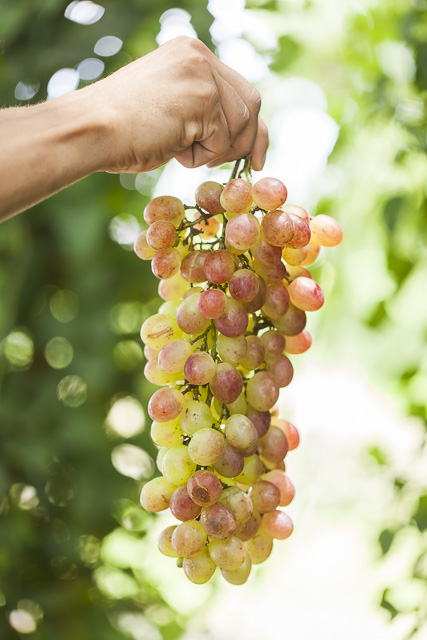 Grapes! Photo by Scott David Gordon.
Grapes! Photo by Scott David Gordon.
Not only are we growing these to fruit, but we are also propagating them for our upcoming transplant sale! Along with persimmons, pomegranates, figs, grapefruits, lemons, limes, mandarins, and twenty different herbs, we will be selling grape plants to you, our lovely farm community! This very exciting transplant sale will be taking place three Saturdays in a row in March. That’s three opportunities for you to visit the farm and stock up on all the starters you need for your Spring Garden. On top of that, our greenhouse manager, Brandon, will be conducting a gardening workshop and dispensing master green-thumb intel with the assistance of none other than the head honcho, Brenton Johnson! Exact date TBD.
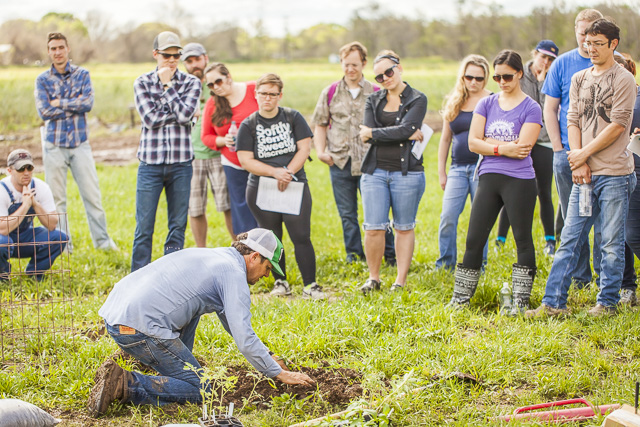 Gardening workshop past. Photo by Scott David Gordon.
Gardening workshop past. Photo by Scott David Gordon.
When it rains at the farm, we’re always challenged to find work for our many employees - muddy conditions are not ideal for planting or harvesting. With the gargantuan amount of rainfall earlier this week, we turned to our grapes to put our staff to work. Most of the grape trellising is done in the first year, but a little needed to be done this week. On the third year of grape production, there is a lot of pruning and tying that needs to be done. For this undertaking, we called upon our grape-whisperer comrade, David, to pop by Garfield and teach us his expert ways. David lives next to our Hergotz packing shed and has been growing grapes in his backyard for years. In his tenure of tending to his grapes, he has cultivated a vast and invaluable knowledge of the fruit, specifically how to grow them in the sometimes tricky Central Texas climate. He gladly took time out of his schedule to come out and demonstrate to our crew the sometimes tricky procedure of pruning and tying grapevines.
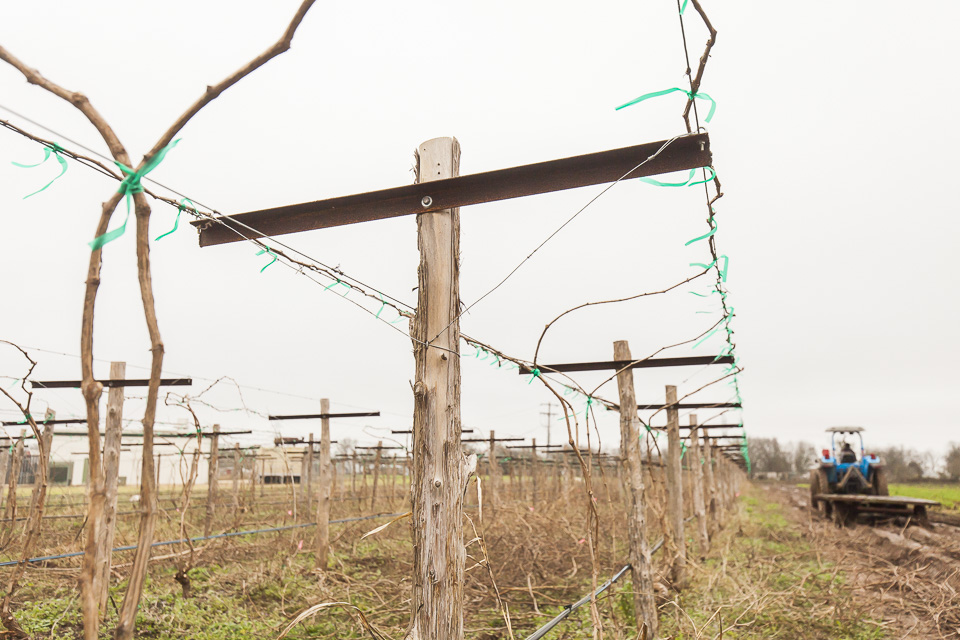
When our grape plants first arrive to the farm, they are around one foot tall, and since the trellis training wire is about four feet tall, the baby grape plants need a training stake to reach the training wire. We had a fleet of bamboo stakes installed for the job (fun fact: bamboo doesn’t rot!). After three years of doing their thing, our grape plants have finally grown tall enough to reach the training wire. After removing these bamboo stakes, it was time for us to get busy pruning. Each grape plant had grown up to five or six different offshoots, so we needed to choose two vines on each plant that we deemed in the best shape, then tied them to the training wire. We had a grand ol’ time lopping off the unwanted vines with an electric reciprocating saw and tossed them into the middle of the row to collect later. The way in which you tie the vine to the wire is immensely important, you don’t want the vines resting on the wire, but you do want the weight of the vine pulling away from the wire. After this was done, we rearranged some of the roots, as some of them had fallen on their side. We used cedar blocks to brace those that had fallen and secure them in an upright position, enabling them to re-root.
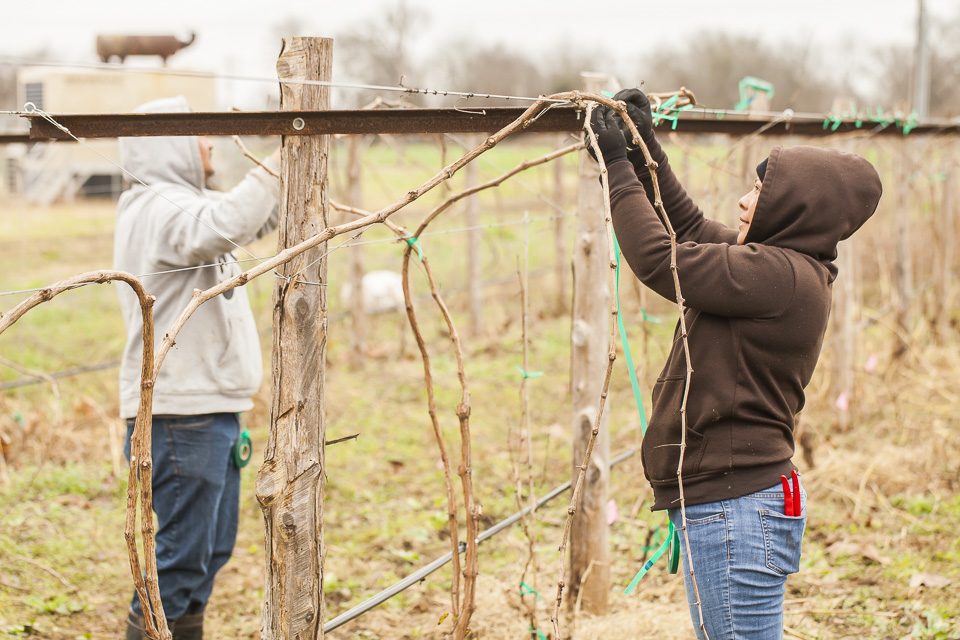 Tying the vines. Photo by Scott David Gordon.
Tying the vines. Photo by Scott David Gordon.
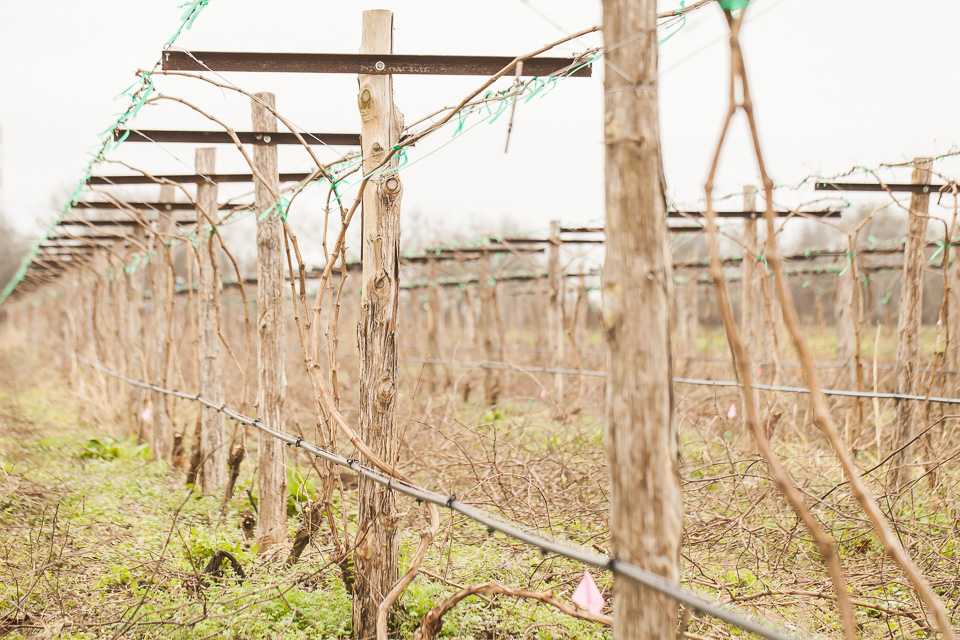 Pruned and tied vines. Photo by Scott David Gordon.
Pruned and tied vines. Photo by Scott David Gordon.
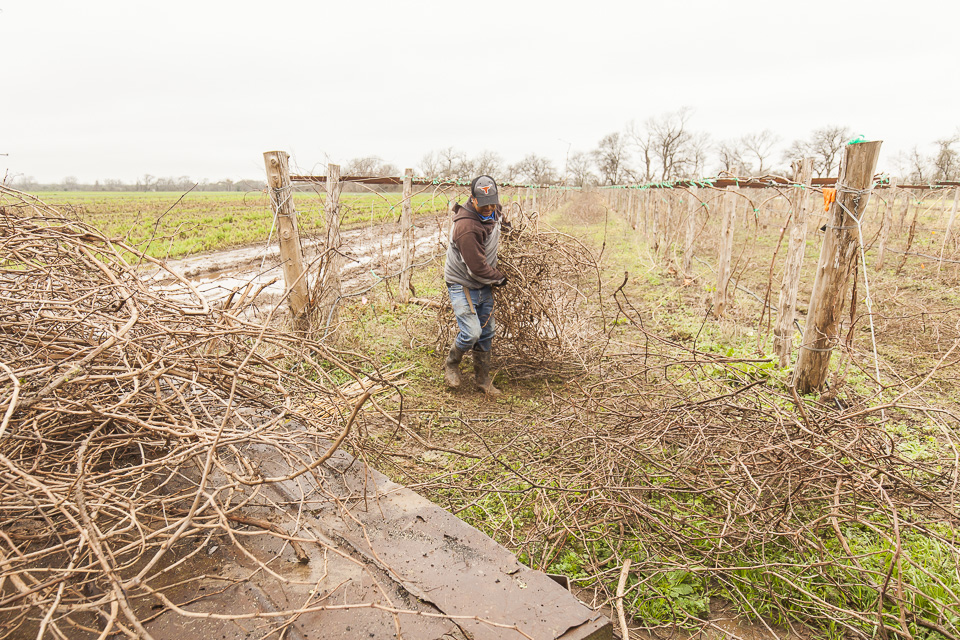 Gathering the cut offshoot vines. Photo by Scott David Gordon.
Gathering the cut offshoot vines. Photo by Scott David Gordon.
Our grapes are grown on grafted rootstock, meaning that the roots of the grapes are different from the fruiting part of the plant. The rootstock that we use absorbs nutrients more effectively from our soil than the original rootstock. Using different rootstock that is more suited to the Central Texas climate and soil circumvents the plants from succumbing to disease and pests, like phylloxera, a pesky microscopic insect that can wreak havoc on grapes (just look up the Great French Wine Blight and you’ll get a taste of their capabilities! Similar to the boll weevil’s effect on cotton plantations in the ‘20s). The rootstock and propagated grape plant, known as the scion, have a rooting chamber. After a couple of years if they have grown together successfully, it’s hard to find the site of the graft if everything is done properly. Pretty cool, right?
We also had to tension the trellises this week, which was quite an interesting experience since we don’t know much about the process, and also, don’t have the correct tools for it. Thank goodness for Charlotte, our assistant farm manager, who figured out a makeshift way to re-adjust the tension of the trellises using advice doled out by an old powerpoint that she unearthed online. She proclaimed it a “classic physics problem” and set out to deduce the tension of the wire. She had to hang a bucket off the training wire in the middle of two stakes and dictated the weight by adding sand and rocks. Depending on how far the bucket hung down, she gleaned the deflection of the wire. Based on how much the bucket weighs, the distance between the poles, and the gauge/strength/length of the wire (we had to call the wire manufacturer and see what the maximum weight it could bear… FYI it’s 1100 lbs!), that’s how you figure the tension! Charlotte went out with the field crew and they tensioned the wires correctly to 900 lbs. They will eventually need to be altered in the summertime, as the change in temperature will cause the wires to shrink and expand, but for now, our trellises are good to go.
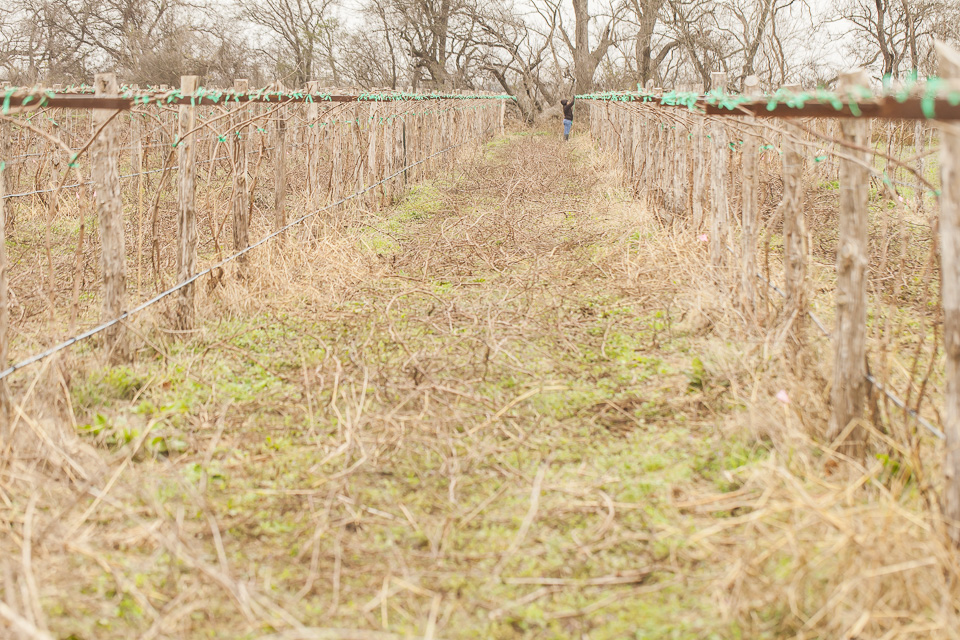 Photo by Scott David Gordon.
Photo by Scott David Gordon.
Finally, we are training the canopies! The type of canopy that we collectively decided would yield the tastiest, fullest, and most voluminous harvest is the Geneva Double Curtain. This type of canopy allows grapes grow in the shade of their own leaves, and the leaves are exposed to the most sun and air. Trust us, these are going to be so tasty! We have two different varieties of grapes growing currently: Victoria Red, a super sweet and delicious table grape bred specifically for Texas soil and climate, and Blanc du Bois, a hardy variety with an exquisite taste. Yum!
 Photo by Scott David Gordon.
Photo by Scott David Gordon.
We are trying our darnedest to get a more expansive offering of fruits for the CSA. It’s a constant struggle to find fruits that will grow successfully in our climate, but we know that people love more fruits than just tomatoes! On top of our grape venture, we are growing figs, two varieties of pomegranates, two kinds of loquats, pears, and planting citrus this year, too! So keep a look out, we have some really exciting produce headed your way. 'Til next time!
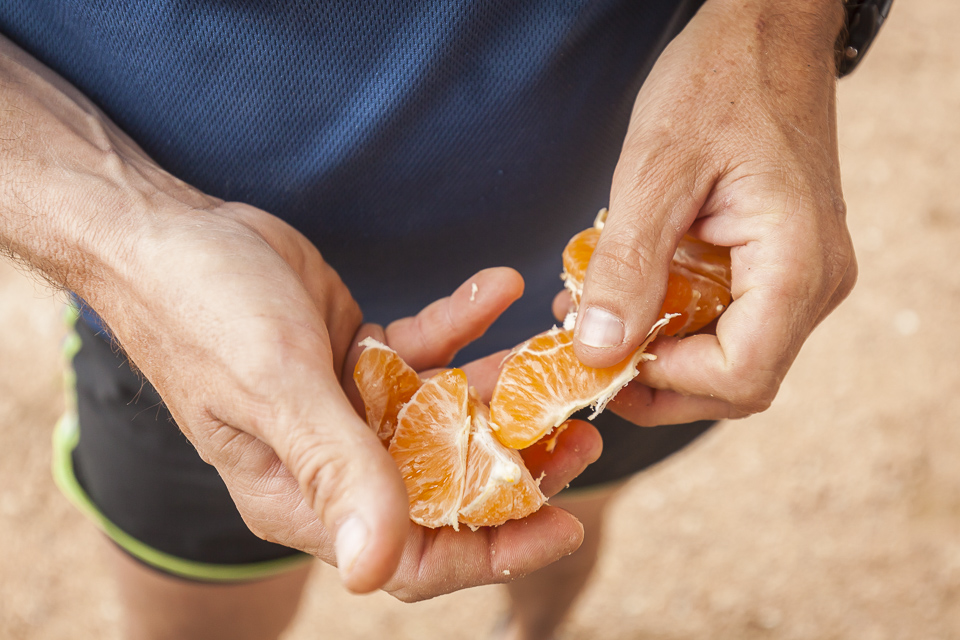 Satsumas in the summertime. Photo by Scott David Gordon.
Satsumas in the summertime. Photo by Scott David Gordon.





 0 ITEMS IN CART
0 ITEMS IN CART 

